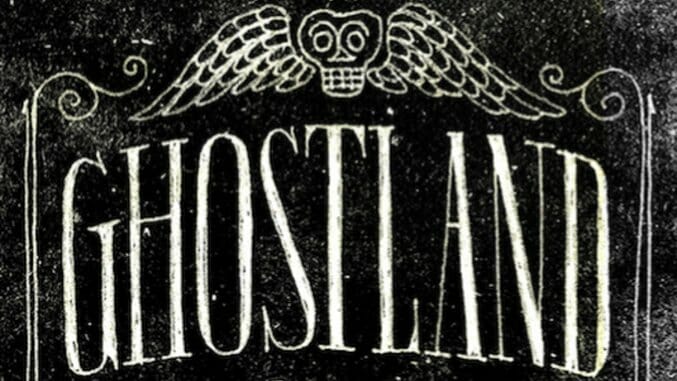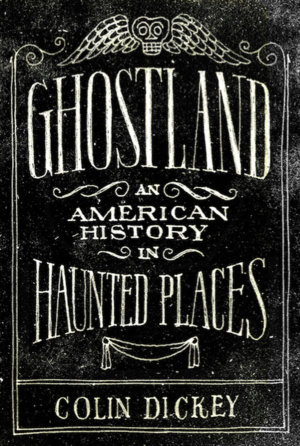
Ghost stories are how we attempt to codify the uncanny and the uncomfortable, the painful and the personal, the romantic and the irredeemably horrible. After all, are not people haunted by lovers and places haunted by tragedies?
By hewing to the facts and using a historian’s loupe, author Colin Dickey seeks to illuminate ghosts’ cultural presence. Ghostland, Dickey’s new book chronicling the sociological history of America’s most haunted places, finds its power not in the numerous phantoms lurking in the country’s shadows, but in the buildings, battlefields, slave prisons and Native American lands that birthed them.
On a rainy morning beneath a funeral veil sky, Paste chatted with Dickey about architecture’s role in hauntings, how the South’s ghost stories are rooted in slavery and technology’s role in the future of specters. (This interview has been edited for length and clarity.)
![]()
Paste: You can’t have a haunting without a story, so it seems like the tales in Ghostland are more important than the ghosts themselves. Do you think that’s a fair thing to say?
Colin Dickey: Yeah. For me, the book arose from two directions. On the one hand, much of this is about the ghost stories that we tell, why we tell those stories and how those stories evolve over time. I think it’s impossible to have a ghost without some kind of story, or at least impossible to have one without a story for very long. People start looking for explanations and reasons to make sense of why they felt the way they felt or why they saw what they think they saw, and those stories come pretty quickly.
But I think the other thing that drove the book is really trying to understand our relationship to place—to specific buildings and architecture and houses—and trying to understand the way that places make us feel. So I was trying to come at that from both of those angles: the direction of place and architecture and history, and also the direction of story and storytelling and how we craft certain narratives to make sense of things.
Paste: Let’s talk about the architecture. If we think of places that are described as haunted or unsettling, there’s often something strange about the bones of the building itself. Why do you think this correlation exists?
Dickey: So when my wife and I bought our first home, we were looking at distressed properties and places at the bottom of the market [post-crash in 2008]. We saw these places that had been altered by previous residents in ways that didn’t make a lot of sense, and we couldn’t quite make sense of them ourselves.
I think that, as a culture, we grow up with certain expectations about how a building can be laid out. You’re not going to open the front door into the bathroom; you’re not going to have all the bedrooms up front and the living room in the back. When those time-honored principles get upended, the building starts to feel a little strange. And we don’t have an immediate language for it. That’s certainly what I found when I started to move through these buildings; the language that I had to understand it didn’t come from any architectural background—which I obviously don’t have—it came from the language of the uncanny and the haunted.
 Paste: It’s almost as if your environment is influenced by people who are no longer there. That’s almost the definition of a haunting, right?
Paste: It’s almost as if your environment is influenced by people who are no longer there. That’s almost the definition of a haunting, right?
Dickey: Exactly. You inhabit places that have left behind traces of their previous occupants. And often that’s not in a supernatural way, that’s in a very literal way—a stain on a wall, a pattern of wear in a carpet. If you think of hotels, every room you’ve stayed in has been occupied by people you’ve never met. These presences work on us in ways that we aren’t consciously aware of, so having that lurking in the back of your mind can create that unsettled or uncanny feeling about a place.
Paste: Do you think that’s one reason why hotels are such popular fodder for hauntings?
Dickey: Right. The home is the place where you’re supposed to feel safe; it’s a place of security and vulnerability. The hotel is the flipside in that it’s supposed to make you feel that way, but is in fact the opposite. Add to that the very real fact that, in many of these places, acts of violence have been perpetrated, and you feel this legacy, even if there’s not a plaque on the wall telling you what happened in room 121.
Paste: In the book, you explain that many of the South’s haunted train yards, forests and rivers may have gained notoriety because of white people trying to scare slaves from running away.
Dickey: That surprised me when I started looking into the various folklore surrounding haunted places. Both pre- and post-Civil War southern whites used the language of ghosts and hauntings to engage in psychological warfare against enslaved people and then the freed black men and women in the aftermath of the Civil War.
The Klan is an example. The iconic Klan white robe didn’t come into being until the 20th century, but the early Klan definitely used spook stories and dressed up as ghosts as a means to terrify the local population. And when you think about how black men and women might have tried to escape from slavery, they’d go through cemeteries and untraveled places. Those places were the most likely to be described as haunted, and some of that came directly from white slave owners who would ride through the forest in a sheet or whatever just to give the sense that there where always ghosts out in the forests.
In many cases, that fed the racist cliché that blacks would be more susceptible to ghost stories than whites. But I think that it’s quite the opposite. When a bunch of drunk, white people show up at your house in the middle of the night carrying guns and claiming to be ghosts, it’s not the supernatural that you’re afraid of—it’s the drunk people that you’re afraid of.
Paste: So they had something legitimate to fear, either way.
Dickey: Exactly.
Paste: Let’s talk about the future of ghosts. You mentioned that each wave of communication technology offers a new opportunity for us to find the paranormal, beginning with the telegraph. And while you’d think that we’d find fewer ghosts in a day and age where pretty much everything is recorded, it’s almost like we have more noise to find more static in. What is the future of ghosts as we get more digitally connected?
Dickey: If you think of a haunted house, a lot of those spooky elements come from the way that architecture decays over time. A building settles into its foundations, and now doors close on their own, floors creak—that’s just a function of aging architecture.
When I was looking at ghosts of the last 10 years, I started to see places like Facebook and Twitter [as those houses]. In the same way, coding and algorithms have bugs that gradually creep into the software architecture to create similar kinds of spooky, unnerving effects.
One of the things I talk about in [Ghostland] is that Facebook used to send you official notifications, “well, you haven’t talked to so-and-so in a while; why don’t you send so-and-so a message,” simply based on an algorithm that identified when you two hadn’t interacted in a while.
That’s fine for the most part. But what happened to me is that I started to get those notifications … and the person in question had actually died six months earlier. Facebook’s algorithms were not smart enough to understand the difference between someone who has left the site and someone who has actually died. So you’d be getting these ghostly reminders from the architecture of Facebook in a way not entirely dissimilar from they way that the architecture of a house might also invoke ghosts and memories of the past.
Paste: Do you think that as records of our own lives become more and more public, we will actually be haunted more?
Dickey: Yeah, exactly. When there are gaps in the historical record, it is often a great way for a ghost story to take root. But just because we now have everything recorded, I don’t think that means that we will cease to have ghosts in our lives. In many ways, it’s the opposite.
What a ghost story provides for us culturally and personally is so powerful that we are going to continue to see them. It’s going to take new forms: photographs on Instagram with blurs that we take as proof of capturing the supernatural; decayed YouTube clips where somebody’s face looks strange and conspiracy theorists will claim that that person is actually a ghost.
We will continue to use the language of haunting and ghosts to talk about the world we live in.